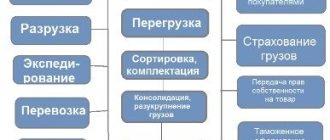What is GDP
Gross Domestic Product (GDP) is the value of all goods and services produced in a country to the end consumer. Only market prices for the final product are taken into account without the cost of its constituent materials. For example, the price of a car is taken into account in GDP, but the cost of the metal, plastic and rubber from which the car is made is not counted, since it is already included in the final price of the car. This avoids double counting of the same products.
The indicator does not distinguish between production purposes: for domestic consumption or for export - it does not matter. GDP is calculated in order to assess the level of production in a particular country and compare it with other countries and previous years.
Dynamics of Russia's GDP
This graph shows that the dynamics of Russia’s GDP almost completely repeats the cycles of growth and decline of the main indicators of the country’s economy. The decline in the early 90s, as the “bottom” was reached, gave way to growth in 1997, but then default struck.
After the economic recovery and the increase in its export potential, as a result of rising world energy prices, significant growth in GDP began (the famous idea of doubling the country’s GDP dates back to this period).
Positive dynamics were observed before the start of the global crisis of 2008-2009. Then GDP began to grow again, recouping the sharp decline – until the “Crimean spring”. Then sanctions, restructuring of the economy to work in new conditions - and again gradual growth based on import substitution and large infrastructure projects.
And here is the dynamics of growth of gross domestic product in nominal (dollar) terms. Here, as we see, the changes are the same as in percentages.
Growth dynamics of gross domestic product in nominal (dollar) terms
Gross domestic product is calculated in the national currency, and for comparison with other countries it is either converted into dollars at the exchange rate, or the comparison is based on purchasing power parity (a set of goods and services is taken and how much it costs in different currencies is calculated). An example of such a comparison is in the graph below.
GDP of the world's leading countries as of December 1, 2018
The concept of GDP comes from the English word “Gross Domestic Product” (in the international tradition, this indicator is denoted by the abbreviation GDP). The gross domestic product indicator was first used in the United States in 1934 after State Department economist Simon Kuznets developed and presented to Congress a method for calculating it. For his outstanding contribution to the development of economic science, including the development of the concept of GDP, Kuznets received the Nobel Prize, and the methods he created are still used today.
GDP affects indicators that are important for the economy: stock indices, exchange rates, asset values, and the credit policy of state central banks. The higher the GDP, the stronger (more expensive relative to foreign ones) the national currency.
A decrease or minimal growth in gross domestic product may indicate that effective demand is shifting towards imports (the population is buying more and more products produced outside the country); the purchasing power of the population is decreasing; lending rates are rising, as a result of which the profitability of enterprises is falling and production volumes are declining; World prices for exported goods decrease, which is why its output decreases.
There is also an impact of GDP on the unemployment rate. If GDP rises by less than 2% per year, the unemployment rate almost inevitably rises. When gross domestic product grows by more than 3%, each subsequent percentage point results in a decrease in unemployment of 0.1%.
GDP at PPP
PPP is purchasing power parity, a comparison of two or more monetary units of different countries. In simple words, when calculating, special American rating agencies calculate the gross domestic product in monetary terms. After this, they calculate how many goods and services can be purchased with the money of this state.
GDP per capita by purchasing power parity from 1990 to 2020
UN international comparisons take into account about 700 basic goods and services, 250 investment objects, 15 standard objects under construction. Then the cost of the totality of objects in these areas is determined in national currency and when converted to US dollars at US prices.
How is GDP different from GNP?
Similar abbreviations have very different meanings. Gross domestic product is the sum of the value of all goods and services produced and provided within a country. Any individuals, legal entities or individual entrepreneurs, regardless of their nationality.
And gross national product (GNP) is the total value of goods and services produced only by companies registered in the country, even if the services themselves were provided outside its borders. This indicator is needed to calculate national income.
The difference between GNP and GDP can be demonstrated with the following example: if a German citizen provides tourism services on the territory of the Russian Federation, then the cost of the services provided by him will be taken into account in Russia’s GDP and in Germany’s GNP.
If the production is completely owned by a foreign company (there are no Russian owners, even fictitious ones), then such production is not taken into account in the GNP, but is taken into account in the GDP, since taxes are paid on it to the budget of the Russian Federation.
In relation to Russia: GDP takes into account everything that is produced on the territory of the Russian Federation by any organizations, while GNP takes into account everything that is produced by Russian organizations, no matter where they are located.
Why is GDP needed?
The annual calculation of GDP allows you to compare the numerical values of this indicator over a certain period of time. In this way, the dynamics of the country's economic development are monitored.
This indicator allows you to analyze the real state of economic development of the state and the level of well-being of its citizens.
Knowledge of the indicator and analysis of its dynamics is necessary to regulate the state’s credit policy and to determine the exchange rate of the national currency in relation to the currencies of other countries.
For example, the higher the GDP in Russia, the more stable the economy and the higher the ruble exchange rate. If this indicator decreases, this indicates that imports of goods have increased, and domestic production has decreased.
Therefore, the policy of import substitution is very important for the country’s economy. The more Russian-made goods there are in a country, the higher the GDP, the stronger the ruble exchange rate and the higher the well-being of Russian citizens.
Types of GDP
Gross domestic product can be calculated as nominal or real. The difference is in the way prices for goods and services are recorded.
Nominal GDP
This type of GDP is calculated in prices of the period taken for calculation, and within a maximum of one budget year. For example, 2020 GDP is calculated in prices for goods and services that were in effect in 2018. This makes it possible to assess not only the volume of production of goods and services, but also to assess the dynamics of prices for them.
There is also a downside: the inability to draw conclusions about changes in the real sector of the economy. Let’s say an enterprise sold goods worth a billion rubles in 2017, and in 2018 – already 1.1 billion. A GDP growth of 10% in this case can show both an increase in production and an increase in prices. In order to clear the indicator from external factors (inflation, for example), real GDP is calculated on the basis of nominal GDP.
Real GDP
In this case, gross domestic product is calculated from the level of a predetermined base year, adjusted for inflation. For example, after the 2009 crisis, the GDP of the following years was compared with it in order to understand how much the economy had recovered.
Example: let’s take the volume of production and provision of services in the Russian Federation in 2009 as a base. In 2010, goods produced and services provided in Russia at prices of the same 2010 were 13.28% more. Inflation for 2010 was 8.78%. Accordingly, real GDP growth is 13.28% – 8.78% = 4.5%.
Sometimes the comparison is made with 1990 (the last full year of the Soviet period), sometimes with 2014 (also the year of the maximum economic decline), but in general any year can be the base year, depending on the purpose of the calculations. Real GDP allows us to compare the state of the economy over different periods of time with a high degree of reliability.
What is it measured in and how is it calculated?
Because Since the development of the instrument and formula itself was developed in the USA, the question of how GDP is measured disappears by itself. As of 2020, payments are almost always made in American dollars, much less often in Euros. The leading economic role of the United States and the European Union in the world contributes a lot to this state of affairs.
GDP can be calculated based on:
- Income of the population and enterprises (distribution method);
- Expenses of the population and enterprises;
- The value added method, when only net profit (markup) on goods and services is taken into account.
There are other calculation methods, but these three are the main ones in the macroeconomic direction. The difference between them is quite insignificant, so economists can often use only one of the listed methods without compromising the overall assessment of the situation.
Why is GDP calculated?
GDP is one of the main indicators of a country's development. If the volume of gross domestic product grows, it means the economy is developing, the number of goods produced and services provided is increasing, and the income of the population is growing. When GDP stagnates or declines, in most cases we are talking about a crisis in the economy, a drop in production volumes and a reduction in real incomes of the population. Based on the dynamics of GDP, macroeconomic decisions are made by state leaders, and the development strategy of certain countries is determined. In Russia, for example, in the 2000s the slogan “doubling GDP” was popular, and in recent years the idea of entering the top five leading countries in the world in terms of gross domestic product, calculated at purchasing power parity, has been actively discussed (more about this term below - in Answers to readers' questions).
| Place | A country | GDP volume (in billion dollars) |
| 1 | China | 23,3 |
| 2 | USA | 19,4 |
| 3 | India | 9,4 |
| 4 | Japan | 5,6 |
| 5 | Germany | 4,2 |
| 6 | Russia | 3,7 |
* Latest IMF data
GDP is also used to assess possible production growth and the inflation component when planning economic indicators.
If inflation and growth indicators reflected in GDP dynamics are ignored and arbitrarily inflated, the amount of depreciation charges is distorted, the lack of working capital becomes less noticeable (which can result in an unexpected cash gap), and a false sense of profit growth arises, which is fraught with the adoption of incorrect strategic decisions.
If the inflation factor is not sufficiently taken into account, the costs budgeted for the enterprise may turn out to be lower than real ones, this will cause a drop in profitability due to the need to increase costs. This will reduce the company's creditworthiness.
The same is true in the opposite case: a speculative increase in the inflation adjustment, without taking into account information about GDP, can lead to an increase in tax deductions and an overestimation of planned profits. In reality, the profit will be less, this will negatively affect both the operational activities of the enterprise and its investment plans.
What affects GDP?
Gross domestic product is one of the main criteria for the state of the economy in a country. If it grows steadily, the economy develops due to the emergence of new enterprises and an increase in the volume of goods created in already operating factories.
The main factors of GDP growth are:
- attracting additional resources to work,
- increasing the work of enterprises due to scientific and technological progress,
- use of current and innovative technologies,
- advanced training of specialists.
The increase in labor resources can be associated both with an increase in the number of residents of the country and with the emergence of a larger number of able-bodied citizens. Increased educational training leads to an increase in the quality of the workforce. At the same time, the number of production facilities, machines and other means of labor increases.
The difference between actual and potential gross domestic product also has a significant impact on GDP. If the former lags significantly, then manufacturing firms can increase output at a given price level.
GDP is affected by:
- investment funds,
- physical and human capital,
- investing money in infrastructure and fixed capital,
- expenses.
How is GDP calculated?
There are several methods for calculating gross domestic product. All of them are carried out according to a unified UN methodology (“system of national accounts”), which was developed back in the 50s. Let's take a closer look at each of them.
Calculation by income
This method is also called distribution method. Based on data mandatory provided by organizations to statistical authorities, Rosstat summarizes all income of individuals and companies operating in the country. The calculation includes the following indicators:
- salaries and bonuses of individuals;
- gross profit of companies (income after salaries and taxes);
- taxes on production (VAT, land, property taxes, etc.);
- import taxes (import duties);
- rental payments (income from rental real estate, for example);
- depreciation (depreciation of fixed assets of companies, expressed in money);
- interest on deposits in banks.
When using this method, payments not related to the production of products or the provision of services are not taken into account in the GDP formula: pensions, benefits, transactions in the secondary market, payments between individuals.
Cost calculation
This is the so-called end-use method. Within its framework, Rosstat specialists also add up all economically significant costs of market entities operating in the country:
- expenses of individuals;
- state financing of budgetary organizations;
- expenses of non-profit organizations;
- investments in the economy by individuals and legal entities;
- public investments and other expenses of government agencies for the purchase of material assets;
- foreign trade balance (the difference between the value of exported and imported goods).
Calculation of GDP by value added
This method (also called production) makes it possible to determine the role of an industry, direction, or even a specific enterprise in the country’s gross domestic product. GDP using this method is calculated as the difference between the cost of purchased raw materials/materials and the final price of the product. The calculations are carried out by statistical authorities using a special methodology based on information about VAT payment.
Using a specific example, we can consider this: a logging company sold 10 cubic meters of logs for 10,000 rubles. At the sawmill, these logs were turned into moldings and sold for 50,000 rubles (added value - 40,000 rubles). A furniture workshop used moldings to produce wooden furniture, which it sold for 70,000 rubles (added value - 30,000 rubles). The design firm applied a special coating to the furniture and created a stylized collection, selling it for 100,000 rubles. The total added value in this chain was 40,000 + 30,000 + 30,000 = 100,000 rubles.
This method does not take into account transactions in the secondary market, in order to avoid duplication of accounting for the same added value.
What does the change in GDP indicate?
Having understood what GDP is, let's look at why this indicator is important. Thus, any state is engaged in the production of goods and services both for domestic consumption and for export. If their number grows, it means the economy is developing. If for some reason the growth of goods and services declines, they speak of an economic slowdown.
Typically, economists measure its growth rate, that is, the percentage by which an indicator has grown over a certain period (month, quarter, year). In the graph below you can see the US GDP growth rate.
When the growth rate grows at less than 2-3% for several years, it signals a condition called recession. If there is a sharp decline in GDP, this is one of the signals of the onset of an economic crisis.
Based on the dynamics of GDP growth, two more states of the economy are distinguished: stagnation and depression. Stagnation occurs when GDP hardly grows, but there is no sharp decline. When there is a strong decline for several years, this is already called an economic depression and is a protracted crisis.
How to increase GDP
Gross domestic product growth is a goal that all states strive for. Here are the factors that influence GDP growth:
- Growth in the production of goods and provision of services. In order to achieve it, it is necessary to attract additional resources - capital and labor, as well as increase labor productivity - primarily through scientific and technical innovations, the growth of employee competencies and the use of new technologies.
- Increasing the number of people employed in the economy. This is achieved through the opening of new jobs, simplification of bureaucratic procedures when registering a business, establishing high-quality retraining, and in the long term - with a general increase in the birth rate.
- Increasing the means of production, the area of farmland, the number of mineral deposits, and so on.
- Accelerating scientific and technological progress and introducing its fruits into production and other economic processes.
GDP per capita
For example, to identify various financial and economic indicators in a state or in a single entity, gross domestic product per capita is taken into account. The calculation formula is quite simple - GDP is divided by the number of people living in the state. Based on the results obtained, comparative characteristics with other states are made.
This indicator cannot be considered an absolutely accurate characteristic, since the meaning is:
- industry affiliation of production,
- quality of various new products,
- optimal indicators of energy and raw material consumption per unit of production.
Answers to readers' questions
– What is GDP in Purchasing Power Parity – Purchasing Power Parity (PPP) is similar to exchange rates. Only the basis is not the stock market balance, but the product balance. 1 US dollar can buy one loaf of bread. The same loaf can be bought for 40 rubles. Accordingly, the purchasing power parity for the price of bread is 1 dollar to 40 rubles. And Russia’s GDP at PPP will be converted into dollars not at the official rate, say, 66 rubles, but at 40 rubles, that is, it will be 30% higher than the nominal one. And to avoid distortions, the calculations are based not on just bread, but on a set of several hundred products and services. Accordingly, Russia's GDP according to PPP is always higher than real or nominal GDP, since the ruble is undervalued on the stock exchange.
– What is GDP per capita? – The GDP per capita indicator allows you to determine and further monitor the level of well-being of the population. This is GDP divided by the number of inhabitants of the territory (for example, a country or region). According to Rosstat, there were 146,793,744 people living in Russia as of January 1, 2020. The country's real GDP, according to the same department, is $1.267 trillion. We divide the second indicator by the first and get: 1267 billion / 146.8 million = 8.63 thousand dollars or approximately 570 thousand rubles. This is 73rd place in the world. For comparison: the leaders are now Luxembourg ($110 thousand), Switzerland ($80 thousand) and Norway ($73.7 thousand). The ranking of countries is greatly influenced by population size and economic structure. In Switzerland there are few people, but there are many banks - hence the high result. And one of the leaders in absolute GDP in the world - China - due to the huge number of inhabitants, is located next to Russia - in the eighth ten countries in terms of GDP per capita.
But in terms of GDP per capita at purchasing power parity, the situation is different. Here, for each Russian there are 25.5 thousand dollars, and this is 53rd place, between Romania and Croatia. The leading positions are held by Qatar, Macau, Luxembourg and Singapore. Such figures indicate that while the level of production and income of citizens in Russia is not the highest, prices for manufactured goods are also low. This makes it possible to ensure a decent global average level of population consumption. Another thing is that this average level is a very conditional indicator, and not the majority of Russians have it.
– Why is GDP calculated either in rubles or in dollars? – Any methodology for calculating GDP allows you to calculate this indicator both in national and in any other currency. For the purposes of domestic planning and statistics in the Russian Federation, the volume of gross domestic product is announced in rubles. For comparison with other countries, as well as for publications in international media and statistical collections, the GDP of the Russian Federation is calculated in dollars at the average exchange rate of the Central Bank of the Russian Federation for the reporting period (year, quarter, month).
– How accurate is the GDP indicator? – The level of gross domestic product is not an exact calculation of the volume of the economy, but an indication of the dynamics of its development. Many economists (including the author of the term, Simon Kuznets) believe that there is no direct relationship between GDP growth and an increase in the welfare of the state, since, for example, taking into account financial flows only from production and sales in GDP gives a one-sided picture of economic development.
Accounting for operations that reduce natural capital (all products that nature provides - minerals, vegetation, wildlife, etc.) as income (a logging company reduces the amount of natural capital by cutting down trees, selling them and receiving income) is actually encourages depletion of natural resources.
The growth of this component of GDP indicates, rather, the prerequisites for a future decline in economic indicators - coal mining is gradually leading to the depletion of deposits and a decline in coal production.
In addition, the calculation of GDP gives a lot of room for manipulation, since the statistical agency, as a rule, reports to the government of the country, which has a direct interest in the growth of gross domestic product. For example, over the past 3 years, the size of Russia's GDP was twice recalculated by Rosstat upward, and both times this recalculation coincided with the pre-election periods. However, there are other opinions.
The Ministry of Economic Development of the Russian Federation, for example, considers real GDP growth of 3% per year a strategic target, since they are confident that upon reaching this indicator, complete economic stability will occur.
The Department of International Capital Markets of the IMEMO RAS explains the discrepancies between some indicators within the framework of GDP by the presence of the shadow sector of the economy. For example, it is difficult to take into account the income of people working for “gray” salaries. When calculating GDP by expenditure or value added, this inaccuracy is relatively leveled out, but others arise - associated, for example, with double counting of the same manufactured products sold twice during the year, and so on.
Despite this, the independent FBK Institute for Strategic Analysis notes that, in general, the calculation of GDP is close to reality and even attempts to “move” it in one direction or another do not make big changes to the overall picture of economic development.
– Where can I find data on a country’s GDP? – Information on Russia’s GDP for previous periods is calculated and published by Rosstat on its website in the “National Accounts” section: Here, in the “Gross Domestic Product” section, data on GDP dynamics since 1996 is posted in current and constant prices, as well as in comparison with previous ones for years.
Information on the GDP of other countries in the original can be obtained on the IMF website in the “Data” section. The World Bank also conducts its calculation of GDP. Its website provides the dynamics of world GDP since 1990, as well as an estimate of the gross domestic product for all countries of the world.
GDP statistics by nominal volume are maintained by the United Nations (UN), their data is located on this website.
Rosstat has been providing information to all these bodies since the late 1980s. Internal statistics in Russia (“system of national accounts”) are also maintained in accordance with the standards of international financial organizations.
The main difference between GDP and GNP indicators
Now let's move on to the real differences between GDP and GNP. GDP and GNP are two very similar, but completely different concepts.
GDP is the nominal power of the economy within a country. GNP is the nominal economic power of all citizens of a country.
The main difference is that when calculating GDP, foreign companies are taken into account that invest in the country and then withdraw capital back to their homeland. And in the case of calculating GNP, they take the indicator of all residents who invest funds in other countries, and then transfer them back to the country’s economy.
From the point of view of the power of the economy, it would be more correct to measure the GNP indicator, because it gives a more complete picture of what kind of income the country will receive and where it ranks in the world rankings.











